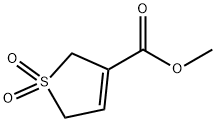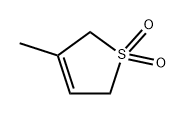3-SULFOLENE
Synonym(s):2,5-Dihydrothiophene 1,1-dioxide, Butadiene sulfone;2,5-Dihydrothiophene-1,1-dioxide;3-Sulfolene
- CAS NO.:77-79-2
- Empirical Formula: C4H6O2S
- Molecular Weight: 118.15
- MDL number: MFCD00005481
- EINECS: 201-059-7
- SAFETY DATA SHEET (SDS)
- Update Date: 2025-06-13 14:48:16

What is 3-SULFOLENE?
Chemical properties
3-SULFOLENE is white crystalline solid
The Uses of 3-SULFOLENE
3-SULFOLENE was used in the isomerization of isoprene rubber. Sulfolene is also an analytical reagent used in the investigation of role of adducts in protein supercharging with sulfolane.
The Uses of 3-SULFOLENE
It is a source of cisoid butadiene for Diels-Alder reactions. This chemical is also a convenient source of sulfur dioxide. It is a solvent used in the petrochemical industry for the extraction of aromatics from hydrocarbon streams.
What are the applications of Application
3-Sulfolene is A source of cisoid butadiene for Diels-Alder reactions.
Definition
ChEBI: Butadiene sulfone is an organosulfur heterocyclic compound.
Properties of 3-SULFOLENE
| Melting point: | 65-66 °C(lit.) |
| Boiling point: | 190.71°C (rough estimate) |
| Density | 1.3 |
| refractive index | 1.4765 (estimate) |
| Flash point: | >230 °F |
| storage temp. | Store below +30°C. |
| solubility | 130g/l |
| form | Powder |
| color | Yellow to orange or light brown |
| Water Solubility | Soluble in water, ethanol, benzene, ether. |
| Merck | 14,8956 |
| BRN | 107004 |
| Stability: | Stable, but decomposes above the melting point. Combustible. Incompatible with strong oxidizing agents. |
| CAS DataBase Reference | 77-79-2(CAS DataBase Reference) |
| EPA Substance Registry System | 3-Sulfolene (77-79-2) |
Safety information for 3-SULFOLENE
| Signal word | Warning |
| Pictogram(s) |
 Exclamation Mark Irritant GHS07 |
| GHS Hazard Statements |
H319:Serious eye damage/eye irritation |
| Precautionary Statement Codes |
P264:Wash hands thoroughly after handling. P264:Wash skin thouroughly after handling. P280:Wear protective gloves/protective clothing/eye protection/face protection. P305+P351+P338:IF IN EYES: Rinse cautiously with water for several minutes. Remove contact lenses, if present and easy to do. Continuerinsing. P337+P313:IF eye irritation persists: Get medical advice/attention. |
Computed Descriptors for 3-SULFOLENE
New Products
4,4-Difluoropiperidine hydrochloride tert-butyl 9-methoxy-3-azaspiro[5.5]undecane-3-carboxylate Indole Methyl Resin N-Isopropylurea N,N-Dicyclohexylcarbodiimide(DCC) MELDRUMS ACID 5-METHYLISOXAZOLE-4-CARBOXYLIC ACID Magnessium Bis glycinate Zinc ascorbate 1-bromo-2-butyne 2-acetamidophenol 9(10H)-anthracenone Erythrosin B, 4-Piperidinopiperidine 2-((4-morpholinophenylamino) (methylthio) methylene) malononitrile 2,4-dihydroxybenzaldehyde 3-(4-morpholinophenylamino)-5-amino-1H-pyrazole-4-carbonitrile Methyl 2-methylquinoline-6-carboxylate 2,6-dichloro-4-nitropyridine 4-Bromo-2-chlorobenzonitrile 2-(benzylamino)acetic acid hydrochloride 4-(tert-Butoxycarbonylamino)but- 2-ynoic acid 3,4-dihydro-2H-benzo[b][1,4]dioxepine 1-Phenyl-1-cycloprppanecarboxylicacidRelated products of tetrahydrofuran


![3-[(4-CHLOROPHENYL)SULFONYL]-2,5-DIHYDRO-1H-1LAMBDA6-THIOPHENE-1,1-DIONE](https://img.chemicalbook.in/StructureFile/ChemBookStructure2/GIF/CB9732524.gif)
![3-([3-CHLORO-5-(TRIFLUOROMETHYL)-2-PYRIDINYL]SULFONYL)-2,5-DIHYDRO-1H-1LAMBDA6-THIOPHENE-1,1-DIONE](https://img.chemicalbook.in/StructureFile/ChemBookStructure2/GIF/CB5336467.gif)

![3-[(4-METHYLPHENYL)SULFONYL]-2,5-DIHYDRO-1H-1LAMBDA6-THIOPHENE-1,1-DIONE](https://img.chemicalbook.in/StructureFile/ChemBookStructure2/GIF/CB7699366.gif)

![3-ACETYL-4-[(4-METHYLPHENYL)SULFANYL]-2,5-DIHYDRO-1H-1LAMBDA6-THIOPHENE-1,1-DIONE](https://img.chemicalbook.in/StructureFile/ChemBookStructure2/GIF/CB2258230.gif)
You may like
-
 3-Sulfolene CAS 77-79-2View Details
3-Sulfolene CAS 77-79-2View Details
77-79-2 -
 3-Sulfolene CAS 77-79-2View Details
3-Sulfolene CAS 77-79-2View Details
77-79-2 -
 Butadiene sulfone CAS 77-79-2View Details
Butadiene sulfone CAS 77-79-2View Details
77-79-2 -
 3-(4-amino-1-oxoisoindolin-2-yl)-1-methylpiperidine-2,6-dione 98%View Details
3-(4-amino-1-oxoisoindolin-2-yl)-1-methylpiperidine-2,6-dione 98%View Details -
 20677-73-0 (2,2-diethoxyethyl)methylamine 98%View Details
20677-73-0 (2,2-diethoxyethyl)methylamine 98%View Details
20677-73-0 -
 3-(4-(hydroxyamino)-1-oxoisoindolin-2-yl)piperidine-2,6-dione 98%View Details
3-(4-(hydroxyamino)-1-oxoisoindolin-2-yl)piperidine-2,6-dione 98%View Details -
 57381-49-4 2-bromo-4-chlorobenzonitrile 98%View Details
57381-49-4 2-bromo-4-chlorobenzonitrile 98%View Details
57381-49-4 -
 4,6-dichloropyrimidine-5-carbaldehyde 98%View Details
4,6-dichloropyrimidine-5-carbaldehyde 98%View Details
5305-40-8
Statement: All products displayed on this website are only used for non medical purposes such as industrial applications or scientific research, and cannot be used for clinical diagnosis or treatment of humans or animals. They are not medicinal or edible.
